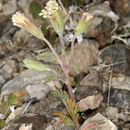Comments
provided by eFloras
Though the derived floral features of Chaenactis macrantha obscure its relationships, it may represent a link between sect. Chaenactis (annuals; pappus scales in regular, often strongly reduced series) and sect. Macrocarphus (leaf blades gland-dotted). Resemblance of its heads, leaves, and indument to those of C. thompsonii and relatives is striking. It appears to form no natural hybrids, perhaps because of its nocturnal corollas.
- license
- cc-by-nc-sa-3.0
- copyright
- Missouri Botanical Garden, 4344 Shaw Boulevard, St. Louis, MO, 63110 USA
Description
provided by eFloras
Plants 5–25(–35) cm; proximal indument grayish, arachnoid-sericeous to closely lanuginose (sometimes tardily glabrescent). Stems mostly 1–5; branches mainly proximal. Leaves basal (withering) and cauline, 1.5–7 cm; largest blades ± elliptic to ovate, ± plane, not succulent, 1(–2)-pinnately lobed (± gland-dotted beneath indument); primary lobes mostly 2–5 pairs, ± remote, ultimate lobes ± plane. Heads (± radiant, nocturnally), mostly 1–5(–7) per stem (nodding in bud). Peduncles 1.5–8 cm, arachnoid-sericeous to thinly lanuginose distally, not stipitate-glandular. Involucres ± obconic to broadly cylindric. Phyllaries: longest 12–18 mm; outer arachnoid-sericeous to thinly lanuginose in fruit, not stipitate-glandular, apices ± squarrose, blunt, pliant. Florets: corollas (nocturnal) white to pinkish or cream, 9–12(–15) mm (lengths 1.8–2.2 times cypselae; anthers ± included); peripheral corollas nocturnally spreading, actinomorphic, scarcely enlarged. Cypselae 5–6(–7) mm; pappi of 8 scales in 2, abruptly unequal series, longest scales 5–7 mm. 2n = 12.
- license
- cc-by-nc-sa-3.0
- copyright
- Missouri Botanical Garden, 4344 Shaw Boulevard, St. Louis, MO, 63110 USA
Comprehensive Description
provided by North American Flora
Chaenactis macrantha DC. Eaton, in S. Wats. Bot. King's Bxpl,
171. 1871. A low annual; stem 1-2 dm. high, branched near the base, floccose when young; leaves 3-5 cm. long, once or twice pinnatifid with oblong obtuse div'sions; peduncles 2-5 cm. long; involucre 12-13 mm. high, 10-15 mm. broad; bracts floccose when young, linear, a few of
the outer ones with spreading or recurved tips, acute, corollas white or flesh-colored, decidedly
pubescent, about 10 mm. long, the marginal ones not much larger than the central ones;
anthers included; achenes 5-6 mm.; squamellae 4, linear-oblong, about half as long as the
corolla, and 2-4 outer oblong cuneate much smaller ones.
Type locality: Foothills, western Nevada.
Distribution: Utah, Arizona, Nevada, and eastern California.
- bibliographic citation
- Per Axel Rydberg. 1914. (CARDUALES); CARDUACEAE; HELENIEAE. North American flora. vol 34(1). New York Botanical Garden, New York, NY
Chaenactis macrantha: Brief Summary
provided by wikipedia EN
Chaenactis macrantha is a species of flowering plant in the daisy family known by the common names bighead dustymaiden and Mojave pincushion. It is native to the Great Basin and the southwestern deserts of the United States, in California, Arizona, Utah, Nevada, southwestern Idaho, and southeastern Oregon. It grows in dry, open habitat with gravelly, sandy soils, often calcareous or alkaline in nature.
Chaenactis macrantha is an annual herb growing one or more branching stems to 30 - 35 centimeters (12-14 inches) in maximum height. The leaves are a few centimeters long and divided into many lobes. The inflorescence bears one or more flower heads on long peduncles. The flower head is lined with woolly phyllaries which have recurved tips. The head contains many white or pink-tinted flowers which open at night. The fruit is an achene about a centimeter long including the pappus.
- license
- cc-by-sa-3.0
- copyright
- Wikipedia authors and editors

